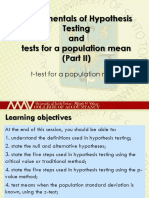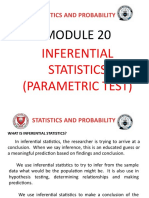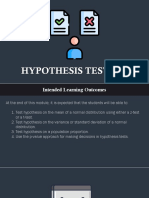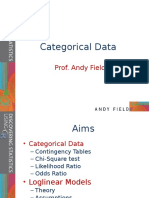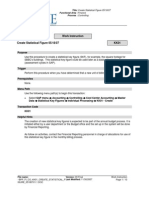As Las 1
As Las 1
Uploaded by
Hazel Mae SarmientoCopyright:
Available Formats
As Las 1
As Las 1
Uploaded by
Hazel Mae SarmientoOriginal Description:
Original Title
Copyright
Available Formats
Share this document
Did you find this document useful?
Is this content inappropriate?
Copyright:
Available Formats
As Las 1
As Las 1
Uploaded by
Hazel Mae SarmientoCopyright:
Available Formats
Name: LEARNING ACTIVITY SHEET 1
One-Sample T-test
T-test
T-test is a statistical test that compares the mean of two groups of data. As a parametric test, t-test assumes
the normality of data distribution and the other assumptions. Depending on the nature of samples, t-test
can be classified as follows:
a. One-Sample T-test
b. Independent Samples T-test
c. Paired Samples T-test
AS_1a.
The t-distribution was developed by an employee of Irish brewery in the person of William S. Gossett. He
chose to publish his findings using the pen name “Student”. To honor his work, the distribution is known today
as “student t-test”. Discuss briefly the history and works of this mathematician.
One-sample t-test
This is a statistical test to compare the population mean and the sample mean. The formula for this t-test
is:
𝑥̅ − 𝜇 (𝑥̅ − 𝜇)√𝑛 − 1
𝑡= 𝑠 𝑜𝑟 𝑡=
⁄ −1 𝑠
√𝑛
Where:
𝑥̅ = 𝑠𝑎𝑚𝑝𝑙𝑒 𝑚𝑒𝑎𝑛 𝜇 = 𝑝𝑜𝑝𝑢𝑙𝑎𝑡𝑖𝑜𝑛 𝑚𝑒𝑎𝑛
𝑠 = 𝑠𝑎𝑚𝑝𝑙𝑒 𝑠𝑡𝑎𝑛𝑑𝑎𝑟𝑑 𝑑𝑒𝑣𝑖𝑎𝑡𝑖𝑜𝑛 𝑛 = 𝑠𝑎𝑚𝑝𝑙𝑒 𝑠𝑖𝑧𝑒
Its degrees of freedom is equal to 𝑑𝑓 = 𝑛 − 1
Example 2.1.1. From the records of Mr. Abad, he found out that the average scores of his students
who took the 30-item pre-test in his Statistics subject is 25.5. He is interested to know whether
this has a significant difference between the scores of his 30 students who got an average
score of 28.4 with a standard deviation of 2.7. Assuming that the data set is normally
distributed, test at 0.05 level of significance.
Take note that before the conduct of hypothesis testing, we do need to be sure that we have satisfied
certain assumptions. These include:
1. The sample was selected with random sampling.
2. The variables are measured at the appropriate level for the test in question.
3. The shape of the sampling distribution of the statistic is known.
To answer the problem, we will test the hypothesis that:
𝐻0 : The mean scores of the previous students and the 30 students are equal.
𝐻𝑎 : The previous students’ and the 30 students’ mean scores differ.
Utilizing the given formula, we determine the t-computed value given that:
𝑥̅ = 28.4, 𝜇 = 25.5, 𝑛 = 30, 𝑎𝑛𝑑 𝑠 = 2.7
(𝑥̅ − 𝜇)√𝑛 − 1 (28.4 − 25.5)√30 − 1 (2.9)√29
𝑡= = = = 5.7841
𝑠 2.7 2.7
Advanced Statistics /LAS 1/Page 1 of 4
The t-critical value can be obtained by looking up on the table of critical values for a t-distribution found
in the appendices of any Statistics book. However, the Microsoft Excel can help you obtain such by
entering the formula:
= T. INV. 2T (α, df) = T. INV. 2T (0.05, 29)
t-critical
It will return 2.0452.
Note that when using this method in deciding whether to accept or reject the hypothesis, if:
• t-statistic < t-critical, do not reject the Ho.
• t-statistic > t-critical, reject the Ho and conclude the Ha.
Since 5.7841 > 2.0452 we reject the null hypothesis and conclude that that the scores of the 30
students are significantly higher than the scores of the previous students.
We can also use significance-based decision making wherein we are going to calculate the probability
associated to the computed t-value using MSExcel function formula.
= TDIST(t statistic , df, tails) = TDIST(5.7841, 29, 2)
P-value
It will return 0.000.
Note that when using this method in deciding whether to accept or reject the hypothesis, if:
• P-value < α, reject the Ho and conclude the Ha.
• P-value > α, accept the Ho.
Since we set 𝛼 = 0.05 and 0.000 < 0.05, we reject the null hypothesis and conclude that the scores of
the 30 students are significantly higher that the scores of the previous students.
AS_1b.
The Department of Education requires school teachers to work 40 hours per week during the school year. A
district school supervisor surveyed 27 randomly selected teachers and found that they work an average of
43.7 hours a week and the standard deviation was 3.46 hours. Test if the mean number of hours worked by
the teachers in the supervisor’s school district differs from what the DepEd requires. Test using 𝛼 = 0.05. Follow
hypothesis testing procedure.
1. Formulate the null and alternative hypothesis.
𝐻𝑜 :
𝐻𝑎 :
2. Decide the level of significance, 𝒂.
The hypothesis will be tested using 𝑎 = ______ level of significance with a degrees of freedom
____________________________________________________________.
3. Choose the appropriate test statistic.
The test that will be used is ___________________________________ because __________________________
_______________________________________________________________________________________________.
4. Compute the value of the statistical test.
Computation:
5. Decide whether to accept or reject the null hypothesis.
Compute t-critical Compute probability/ significance value
using MS Excel: using MS Excel:
𝑡𝑐𝑟𝑖𝑡𝑖𝑐𝑎𝑙 = __________ 𝑝 = __________
Decision: Reject Ho Accept Ho Decision: Reject Ho Accept Ho
Reason: Reason:
6. Draw a conclusion.
Conclusion:
Advanced Statistics /LAS 1/Page 2 of 4
AS_1c.
A private school wants to procure DLP projectors. An electronics company that joined the bidding process
claims that their DLP projectors have bulbs that have a length of life that is approximately normally
distributed with a mean of 800 hours and a standard deviation of 40 hours. Test the hypothesis that 𝜇 = 800
hours against the alternative 𝜇 ≠ 800 hours if a random sample of 30 projector bulbs has an average life of
788 hours. Use a 0.05 level of significance. Follow hypothesis testing procedure.
AS_1d.
The average height of females in the freshman class of a certain college has been 162.5 centimeters. The
height of 25 randomly selected female college freshmen is collected as shown in the table below. Is there a
reason to believe that there has been a change in the average height? Follow hypothesis testing
procedure and use a 0.05 level of significance in testing this claim.
Student Height Student Height Student Height Student Height Student Height
A 145 F 150 K 174 P 166 U 186
B 158 G 167 L 188 Q 188 V 183
C 167 H 187 M 176 R 199 W 182
D 193 I 180 N 155 S 159 X 178
E 148 J 176 O 140 T 198 Y 174
Advanced Statistics /LAS 1/Page 3 of 4
Advanced Statistics /LAS 1/Page 4 of 4
You might also like
- Practical Engineering, Process, and Reliability StatisticsFrom EverandPractical Engineering, Process, and Reliability StatisticsNo ratings yet
- Hypothesis TestingDocument54 pagesHypothesis Testingsiddharth shirwadkarNo ratings yet
- Sleep Duration and The Academic Performance of 12th Grade Senior High School Students, Academic Year 2019 - 2020Document14 pagesSleep Duration and The Academic Performance of 12th Grade Senior High School Students, Academic Year 2019 - 2020Daniel Malhabour100% (6)
- ECON2206 Assignment 2 William Chau z3376203Document5 pagesECON2206 Assignment 2 William Chau z3376203Peter DundaroNo ratings yet
- As Las 2Document5 pagesAs Las 2Hazel Mae SarmientoNo ratings yet
- For The Learners: Math 11 (Statistics and Probability)Document12 pagesFor The Learners: Math 11 (Statistics and Probability)Nune SabanalNo ratings yet
- LR23 Computing Test StatisticDocument26 pagesLR23 Computing Test StatisticBernard BanalNo ratings yet
- Week 5 - 8 Q4 New BaldozaDocument28 pagesWeek 5 - 8 Q4 New BaldozaChelsea Mae AlingNo ratings yet
- MM13 Content Module 7 1Document12 pagesMM13 Content Module 7 1mrkpalmares0524No ratings yet
- MATHunit 3Document17 pagesMATHunit 3andreimanila123No ratings yet
- Assignment Updated 101Document24 pagesAssignment Updated 101Lovely Posion100% (1)
- SLG 28.2 - Procedure in Doing A Test For A MeanDocument7 pagesSLG 28.2 - Procedure in Doing A Test For A Meanrex pangetNo ratings yet
- Unified Supplementary Learning Materials: (UslemDocument10 pagesUnified Supplementary Learning Materials: (UslemISKA COMMISSION100% (1)
- Module 3B - T Tests For A Population Mean With JASP OutputDocument53 pagesModule 3B - T Tests For A Population Mean With JASP OutputKim IgnacioNo ratings yet
- Statppt2 - Test Statistic, Z-Critical & T-CriticalDocument44 pagesStatppt2 - Test Statistic, Z-Critical & T-CriticalpogggigigieigegnNo ratings yet
- One Sample T-TestDocument24 pagesOne Sample T-TestCharmane OrdunaNo ratings yet
- SP LAS 6 Quarter 4 MELC 6Document9 pagesSP LAS 6 Quarter 4 MELC 6Senyang NobletaNo ratings yet
- Topic 7Document26 pagesTopic 7Zienab AhmedNo ratings yet
- Statistical Analysis (T-Test)Document61 pagesStatistical Analysis (T-Test)Symoun BontigaoNo ratings yet
- Paired T TestDocument3 pagesPaired T TestMuhamad Azhari MNo ratings yet
- The Z - Test and T-TestDocument35 pagesThe Z - Test and T-TestSshi Andayan CumahlengNo ratings yet
- Group 6 (T-Test)Document32 pagesGroup 6 (T-Test)Laezel Ann Tahil100% (1)
- Psych Stats ReviewerDocument16 pagesPsych Stats ReviewerReycee AcepcionNo ratings yet
- Measure of Central TendencyDocument40 pagesMeasure of Central TendencybmNo ratings yet
- DoE 2Document24 pagesDoE 2mereninnasNo ratings yet
- Educ. 601Document17 pagesEduc. 601RHONALYN CABULLONo ratings yet
- Hypothesis Testing With T Tests Edited 1Document31 pagesHypothesis Testing With T Tests Edited 1Katharine MalaitNo ratings yet
- Module 20 Inferential Statistics (Parametric Test)Document71 pagesModule 20 Inferential Statistics (Parametric Test)Niño Andrey AmboyNo ratings yet
- 0801 HypothesisTestsDocument4 pages0801 HypothesisTestsshweta3547No ratings yet
- T Test 1Document23 pagesT Test 1Zyrill MachaNo ratings yet
- Sta 305 HW 2Document4 pagesSta 305 HW 2Jasmine NguyenNo ratings yet
- GEC 3 Inferential Statistics t Test.pptxDocument50 pagesGEC 3 Inferential Statistics t Test.pptxkylamagallonesjoyNo ratings yet
- Statistical Analysis 3: Paired T-Test: Research Question TypeDocument4 pagesStatistical Analysis 3: Paired T-Test: Research Question TypeRetno Tri Astuti RamadhanaNo ratings yet
- Practical Research 2 Q2 LessonDocument7 pagesPractical Research 2 Q2 LessonTryrix AmveusNo ratings yet
- An Introduction To T-Tests: Statistical Test Means Hypothesis TestingDocument8 pagesAn Introduction To T-Tests: Statistical Test Means Hypothesis Testingshivani100% (1)
- L10 11 Hypothesis & ANOVADocument13 pagesL10 11 Hypothesis & ANOVAAlvi KabirNo ratings yet
- Paired - Sample T Test (Part 3)Document4 pagesPaired - Sample T Test (Part 3)kinhai_seeNo ratings yet
- Chapter 6 Hypothesis TestDocument22 pagesChapter 6 Hypothesis TestManraz ManrazNo ratings yet
- Exercises Ch9 Hypo Tests Mean ProportionsDocument21 pagesExercises Ch9 Hypo Tests Mean ProportionsAhmad MalakNo ratings yet
- Tests of Hypotheses: 5 Steps in The Hypothesis Testing ProcedureDocument4 pagesTests of Hypotheses: 5 Steps in The Hypothesis Testing ProcedureNikit ChaudharyNo ratings yet
- AP Statistics Practice ExamDocument7 pagesAP Statistics Practice ExamldlewisNo ratings yet
- Experimental PsychologyDocument36 pagesExperimental PsychologyPatricia Ann E ANo ratings yet
- Inferential Statistics For Print Part IDocument23 pagesInferential Statistics For Print Part IAgazziNo ratings yet
- Chapter No. 03 Experiments With A Single Factor - The Analysis of Variance (Presentation)Document81 pagesChapter No. 03 Experiments With A Single Factor - The Analysis of Variance (Presentation)Sahib Ullah MukhlisNo ratings yet
- Hypothesis TestingDocument30 pagesHypothesis TestingNishikata ManipolNo ratings yet
- Unit IIDocument118 pagesUnit IInikitaabraham7No ratings yet
- PMT PracticalDocument12 pagesPMT Practicaldenithmayon1No ratings yet
- Stats PTDocument15 pagesStats PT「 」No ratings yet
- Sardilla's Report On Advance StatisticDocument32 pagesSardilla's Report On Advance Statisticsabel sardillaNo ratings yet
- TSU Thesis TeacherKit Chapter 3Document7 pagesTSU Thesis TeacherKit Chapter 3Marvin Yebes ArceNo ratings yet
- Stat C9Document18 pagesStat C9Princess Lynn Aquino Padua100% (1)
- Group 4 (Analysis of Variance)Document80 pagesGroup 4 (Analysis of Variance)Ger C. DecenaNo ratings yet
- Department of Education: Learner'S Activity Sheet For Quarter 4, Week 4 Statistics and ProbabilityDocument14 pagesDepartment of Education: Learner'S Activity Sheet For Quarter 4, Week 4 Statistics and ProbabilityFranzhean Balais CuachonNo ratings yet
- Hypothesis Test - Difference in MeansDocument4 pagesHypothesis Test - Difference in Meansr01852009paNo ratings yet
- Regression AnalysisDocument68 pagesRegression AnalysisTewabeNo ratings yet
- Edur 8131 Notes 5 T TestDocument23 pagesEdur 8131 Notes 5 T TestNazia SyedNo ratings yet
- STAT Q4 Week 4 Enhanced.v1Document14 pagesSTAT Q4 Week 4 Enhanced.v1queenkysultan14No ratings yet
- Dsur I Chapter 18 Categorical DataDocument47 pagesDsur I Chapter 18 Categorical DataDannyNo ratings yet
- Inferential Statistics 1Document88 pagesInferential Statistics 1Gracelyn MaalaNo ratings yet
- Schaum's Easy Outline of Probability and Statistics, Revised EditionFrom EverandSchaum's Easy Outline of Probability and Statistics, Revised EditionNo ratings yet
- Chap08 Moving Average Control Charts 2Document23 pagesChap08 Moving Average Control Charts 2john brownNo ratings yet
- Effect of Flood On Businesses in SwatDocument8 pagesEffect of Flood On Businesses in SwatAliNo ratings yet
- Hul RuralDocument21 pagesHul Ruralchirag_nrmba15100% (1)
- Kemoreseptor Udang B1A020001-Alika Fauziah R2K1Document9 pagesKemoreseptor Udang B1A020001-Alika Fauziah R2K1Alika FauziahNo ratings yet
- Research MethodologyDocument30 pagesResearch MethodologyYashwanth sai YachareniNo ratings yet
- Webmindä Self-Organizing, Network-Based Business IntelligenceDocument21 pagesWebmindä Self-Organizing, Network-Based Business IntelligencejbshirkNo ratings yet
- Summary Note. Introduction To Statistical InferenceDocument2 pagesSummary Note. Introduction To Statistical InferenceRazel Tercino100% (1)
- Regression and CorrelationDocument9 pagesRegression and CorrelationswiftmessiNo ratings yet
- Student's full name: - Trần Chí Cường - Nguyễn Anh Quân - Dương Thành Đạt Class: MKT1501 Lecturer: Nguyễn Việt Anh Group Assignment MAS 202 Summary of chapter 13 I. Simple Linear Regression ModelsDocument7 pagesStudent's full name: - Trần Chí Cường - Nguyễn Anh Quân - Dương Thành Đạt Class: MKT1501 Lecturer: Nguyễn Việt Anh Group Assignment MAS 202 Summary of chapter 13 I. Simple Linear Regression Modelshi AhiNo ratings yet
- Bussiness Statistics BookDocument5 pagesBussiness Statistics BookSikandar AliNo ratings yet
- Revise Paper Introduction and MethodDocument9 pagesRevise Paper Introduction and MethodGogs Ediza AlejoNo ratings yet
- Quizzer 8Document6 pagesQuizzer 8CriscelNo ratings yet
- Does Aid Matter? Measuring The Effect of Student Aid On College Attendance and CompletionDocument33 pagesDoes Aid Matter? Measuring The Effect of Student Aid On College Attendance and CompletionCindy LuNo ratings yet
- Dielectric Properties of Tissues at Microwave FrequenciesDocument50 pagesDielectric Properties of Tissues at Microwave FrequenciesDejan100% (1)
- ITC Infotech Quality Management SystemDocument16 pagesITC Infotech Quality Management SystemKamkeung HoNo ratings yet
- Qualitative vs. Quantitative Research DifferencDocument1 pageQualitative vs. Quantitative Research Differenckarlavictoria.inventorNo ratings yet
- Statistics and Probability NotesDocument9 pagesStatistics and Probability NotesKent DanielNo ratings yet
- T-Test AssignmentDocument2 pagesT-Test AssignmentChelsea DizonNo ratings yet
- SKF ProcessDocument10 pagesSKF Processraote7No ratings yet
- Sbs Mathematics Statistics and Operational Research 23Document37 pagesSbs Mathematics Statistics and Operational Research 23YNo ratings yet
- Strengths and Weaknesses of Quantitative ResearchDocument1 pageStrengths and Weaknesses of Quantitative ResearchJhimson CabralNo ratings yet
- Financial LiteracyDocument8 pagesFinancial LiteracyMaria Christina SerenoNo ratings yet
- CS490 Advanced Topics in Computing (Deep Learning)Document37 pagesCS490 Advanced Topics in Computing (Deep Learning)Afaq AhmedNo ratings yet
- Clustering ProjectDocument44 pagesClustering Projectkirti sharma100% (1)
- EE2211 Introduction To Machine Learning: Semester 1 2021/2022Document34 pagesEE2211 Introduction To Machine Learning: Semester 1 2021/2022Adel LeeNo ratings yet
- Tennis StrategyDocument8 pagesTennis StrategyballerzazaNo ratings yet
- QA IndexDocument8 pagesQA IndexAzlan PspNo ratings yet
- Module 4Document5 pagesModule 4jungoosNo ratings yet













